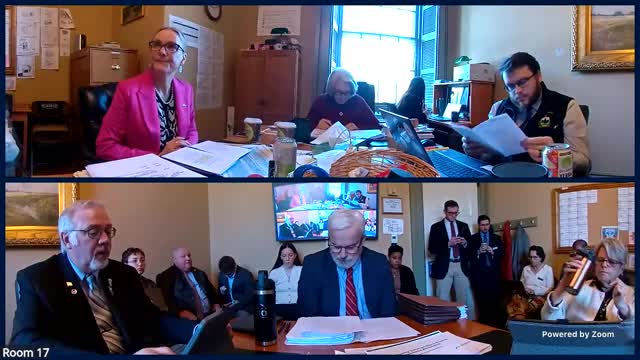Vermont committee deliberates on PFAS regulations for consumer products and containers
April 19, 2025 | Health & Welfare, SENATE, Committees, Legislative , Vermont
This article was created by AI summarizing key points discussed. AI makes mistakes, so for full details and context, please refer to the video of the full meeting. Please report any errors so we can fix them. Report an error »

In a recent meeting of the Vermont Senate Health and Welfare Committee, lawmakers engaged in a detailed discussion about proposed regulations concerning per- and polyfluoroalkyl substances (PFAS) in consumer products. The atmosphere was charged with a sense of urgency as committee members navigated the complexities of defining and regulating these chemicals, which have raised significant health concerns.
One of the key topics was the definition of PFAS and how it is introduced into products. The committee reviewed changes made by the House, which aimed to clarify that PFAS should not be considered "intentionally added" if it is present due to the use of water or feed in the manufacturing process. This distinction is crucial, as it determines the responsibility of manufacturers in disclosing PFAS content. The Attorney General's office contributed to the discussion, advocating for language that would ensure manufacturers are held accountable for PFAS found in products made with water from public systems that meet established safety standards.
The committee also addressed the inclusion of specific consumer products in the regulations, such as juvenile items, cookware, and cleaning products. Notably, there was a push to prohibit PFAS in pacifiers, highlighting growing concerns about children's exposure to harmful chemicals. The conversation underscored the importance of protecting vulnerable populations, particularly children, from potential health risks associated with PFAS.
As the meeting progressed, the committee examined the implications of these regulations on various industries, including textiles and outdoor apparel. They discussed the need for a balance between public health and the economic impact on manufacturers. The proposed regulations would not only restrict the use of PFAS but also set a timeline for compliance, with some provisions aiming for implementation by 2030.
In a moment of levity, committee members shared anecdotes about local youth engaged in skiing, connecting the discussion back to the community and the importance of safe products for future generations. This blend of serious policy discussion and personal connection illustrated the committee's commitment to ensuring that Vermont's regulations reflect both scientific understanding and community values.
As the meeting concluded, the committee recognized the need for further testimony and input from various stakeholders, including environmental groups and industry representatives. The path forward remains complex, but the commitment to addressing PFAS in consumer products is clear, signaling a proactive approach to safeguarding public health in Vermont.
One of the key topics was the definition of PFAS and how it is introduced into products. The committee reviewed changes made by the House, which aimed to clarify that PFAS should not be considered "intentionally added" if it is present due to the use of water or feed in the manufacturing process. This distinction is crucial, as it determines the responsibility of manufacturers in disclosing PFAS content. The Attorney General's office contributed to the discussion, advocating for language that would ensure manufacturers are held accountable for PFAS found in products made with water from public systems that meet established safety standards.
The committee also addressed the inclusion of specific consumer products in the regulations, such as juvenile items, cookware, and cleaning products. Notably, there was a push to prohibit PFAS in pacifiers, highlighting growing concerns about children's exposure to harmful chemicals. The conversation underscored the importance of protecting vulnerable populations, particularly children, from potential health risks associated with PFAS.
As the meeting progressed, the committee examined the implications of these regulations on various industries, including textiles and outdoor apparel. They discussed the need for a balance between public health and the economic impact on manufacturers. The proposed regulations would not only restrict the use of PFAS but also set a timeline for compliance, with some provisions aiming for implementation by 2030.
In a moment of levity, committee members shared anecdotes about local youth engaged in skiing, connecting the discussion back to the community and the importance of safe products for future generations. This blend of serious policy discussion and personal connection illustrated the committee's commitment to ensuring that Vermont's regulations reflect both scientific understanding and community values.
As the meeting concluded, the committee recognized the need for further testimony and input from various stakeholders, including environmental groups and industry representatives. The path forward remains complex, but the commitment to addressing PFAS in consumer products is clear, signaling a proactive approach to safeguarding public health in Vermont.
View full meeting
This article is based on a recent meeting—watch the full video and explore the complete transcript for deeper insights into the discussion.
View full meeting